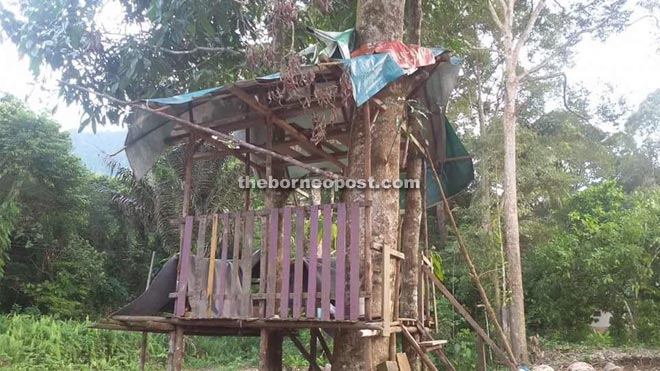
The Internet hotspot treehouse that Lawrence built.
KUCHING: When he was a student last year, Lawrence, 18, had to climb two metres up a tree to do his homework and school revision in an ‘Internet hotspot treehouse’ near house.
The Internet hotspot treehouse, which he personally built, was the only spot he could use his notebook to connect to the internet as his village Kampung Bobak Sejinjang, Singgai, Bau still does not have Internet coverage.
When by chance he discovered one particular spot near a tree in his house compound which can receive some Internet coverage, probably transmitted from a nearby village, he decided to build a house up on the tree to get better transmission.
Lawrence’s father Kerbun Kira when contacted yesterday said the treehouse built two metres above the ground was his son’s initiative and it took him about a week to finish without help from anyone.
“There is no Internet coverage at home so he had to search for the coverage outside the house and he found a location where Internet coverage is available. That is where he built his treehouse,” he said.
According to Kerbun, Lawrence did his school work and research in his treehouse until he completed his Form 5 last year.
Lawrence, the second of four siblings, is now working but the treehouse still serves its purpose and it is now used by his two other siblings who are studying at Universiti Malaysia Sarawak and SMK Lake in Bau.
PKR Mas Gading branch chief Boniface Willy Tumek, who chanced upon this unique wooden ‘Internet hotspot’ structure recently, found out that the village (Bobak Sejinjang) was the only village in Singgai that is not a ‘wireless village’ (kampung tanpa wayar).
“Internet connectivity is a major issue in many villages in Bau. In villages like Stass and Skibang, the people cannot even use their mobile phones despite there being a Sacofa telecommunication tower there.”
According to him, the tower was built in March this year but so far, telco companies have been reluctant to extend their coverage there.
With Internet connectivity being a major issue in rural areas like Bau, it is doubtful that students in these areas could benefit from the 1BestariNet, a virtual learning environment (VLE) initiated by the Education Ministry to provide high speed Internet access to every school in the country. The 1BestariNet project is estimated to cost about RM4.1 billion.
According to the Education Ministry’s Malaysian Education Blueprint annual report 2014, a total of 6,623 schools had been connected to high speed wireless 4G Internet by end of 2014, while another 2,261 school were connected via
Asymmetric Digital Subcriber Line (ADSL) and Very Small Aperture Terminal (VSAT) technology.
The report also said the 1BestariNet network required the construction of telecommunication towers to support high speed 4G connectivity. The ministry is working towards obtaining the cooperation of local authorities in building these towers.
As an interim measure, the remaining schools are currently connected to other Internet Service Providers (ISP). These schools will migrate to 1BestariNet in Phase 2 of the project this year.
